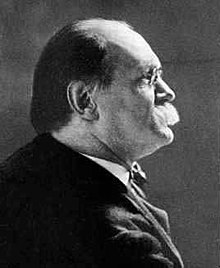Proponiamo un problema di un grande compositore, che disponeva tra le altre qualità di un marcato senso dell'umorismo. Il lavoro che segue ne è la prova... : il Bianco gioca e vince in due mosse. Buon divertimento ai solutori...
M.M.
Sam Loyd 1887 - matto in 2 mosse
Samuel Loyd
Da Wikipedia, l'enciclopedia libera.
Samuel Loyd (Filadelfia, 31 gennaio 1841 – New York, 10 aprile 1911) è stato uno scacchista, compositore di scacchi e creatore di enigmi matematici statunitense.È cresciuto a New York.
Era un buon giocatore ma non ad altissimo livello. Partecipò ad un solo torneo importante, Parigi 1867 (vinto da Ignatz von Kolisch davanti a Simon Winawer e Wilhelm Steinitz), nel quale si classificò =9° con Rosenthal su 13 partecipanti.
Come compositore di problemi di scacchi ha invece raggiunto un livello tale da venir considerato come un' icona in questo campo. Compose principalmente problemi in tre o più mosse, ma anche in due mosse. Oltre ad una notevole originalità, i suoi problemi hanno a volte degli spunti umoristici, oppure la soluzione si svolge come una divertente storiella.
Creò anche problemi "ad hoc", cioè riferiti ad eventi particolari. In occasione del match per il titolo mondiale tra Steinitz e Zukertort del 1866, compose un problema di matto in due in cui i pezzi formano le lettere " Z " e " S ", le iniziali dei due contendenti. Inoltre si può risolvere sia con mossa al bianco che al nero. Una composizione che ben esemplifica la sua genialità in questo campo (vedi diagramma sotto). Compose alcuni problemi assieme al problemista e amico William Shinkman.
Loyd è famoso anche per aver inventato il popolare gioco del quindici, ma ultimamente alcuni studiosi hanno avanzato l'ipotesi che non sia stato veramente lui a crearlo, ma che abbia solo modificato una versione preesistente [1]
Sam Loyd amava molto il tangram, e pubblicò un libro con centinaia di configurazioni originali, corredato da una storia fantasiosa sulle origini di questo rompicapo.
Nel 1914, dopo la sua morte, il figlio Sam Loyd Junior pubblicò la Cyclopedia of Puzzles, una raccolta che contiene 5000 suoi problemi e rompicapi. [2]
Note
- ^ Jerry Slocum e Dick Sonneveld: The 15 Puzzle (ISBN 1-890980-15-3)
- ^ Sam Loyd's Cyclopedia of Puzzles
Samuel Loyd (January 30, 1841 – April 10, 1911),[1] born in Philadelphia and raised in New York, was an American chess player, chess composer, puzzle author, and recreational mathematician.
As a chess composer, he authored a number of chess problems, often with interesting themes. At his peak, Loyd was one of the best chess players in the U.S., and was ranked 15th in the world, according to chessmetrics.com. His playing style was flawed, as he tried to create fantastic combinations over the board, rather than simplifying and going for the win.
He played in the strong Paris 1867 chess tournament (won by Ignatz von Kolisch) with little success, placing near the bottom of the field.
Following his death, his book Cyclopedia of 5000 Puzzles[2] was published (1914) by his son. His son, named after his father, dropped the "Jr" from his name and started publishing reprints of his father's puzzles.[3] Loyd was inducted into the U.S. Chess Hall of Fame.
Loyd is widely acknowledged as one of America's great puzzle-writers and popularizers, often mentioned as the greatest—Martin Gardner called him "America's greatest puzzler", and The Strand in 1898 dubbed him "the prince of puzzlers".
However, he is also known for lies and self-promotion, and criticized on these grounds—Martin Gardner's assessment continues "but also obviously a hustler", Canadian puzzler Mel Stover called Loyd "an old reprobate", and Matthew Costello calls him both "puzzledom's greatest celebrity...popularizer, genius," but also "huckster...and fast-talking snake oil salesman."[4]
Loyd claimed from 1891 until his death in 1911 that he invented the fifteen puzzle, for example writing in the Cyclopedia of Puzzles (published 1914), p. 235:
- The older inhabitants of Puzzleland will remember how in the early seventies I drove the entire world crazy over a little box of movable pieces which became known as the "14–15 Puzzle".
- Sam Loyd did not invent the 15 puzzle and had nothing to do with promoting or popularizing it. The puzzle craze that was created by the 15 Puzzle began in January 1880 in the US and in April in Europe. The craze ended by July 1880 and Sam Loyd's first article about the puzzle was not published until sixteen years later, January 1896. Loyd first claimed in 1891 that he invented the puzzle, and he continued until his death a 20 year campaign to falsely take credit for the puzzle. The actual inventor was Noyes Chapman, the Postmaster of Canastota, New York, and he applied for a patent in March 1880.
References
- ^ Harry Golombek, Golombek's Encyclopedia of Chess, 1977, ISBN 0-517-53146-1
- ^ Sam Loyd's Cyclopedia of 5000 Puzzles, Tricks and Conundrums with Answers ISBN 0-923891-78-1
- ^ Martin Gardner's Mathematical Puzzles and Diversions Chapter 9 Pg 79
- ^ Costello, Matthew J. (1996-09-16), The Greatest Puzzles of All Time, Courier Dover Publications, p. 45 (Sam Loyd and the Vanishing Puzzle), ISBN 978-0-486-29225-0
- ^ The 15 Puzzle (ISBN 1-890980-15-3): by Jerry Slocum and Dic Sonneveld
- ^ Sam Loydʼs Most Successful Hoax
- ^ Alain C. White, Sam Loyd and his chess problems, 1913, p. 125














Nessun commento:
Posta un commento